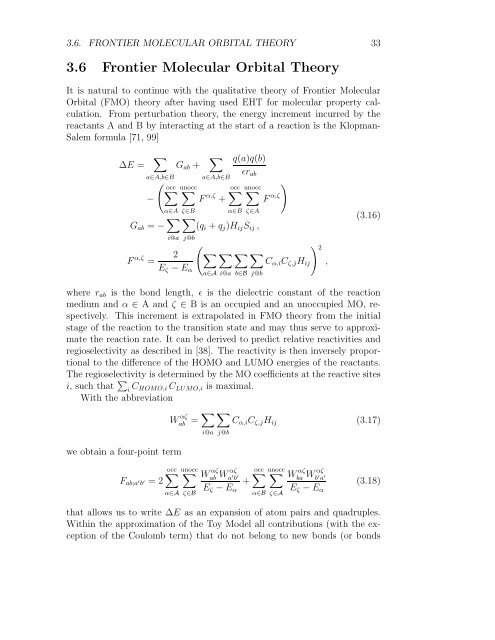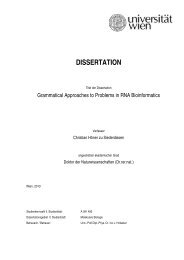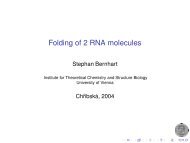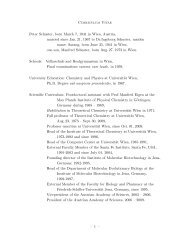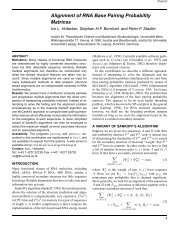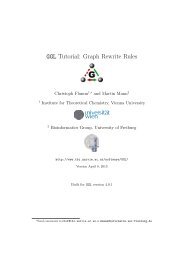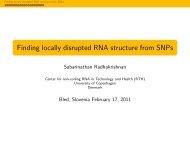A Toy Model of Chemical Reaction Networks - TBI - Universität Wien
A Toy Model of Chemical Reaction Networks - TBI - Universität Wien
A Toy Model of Chemical Reaction Networks - TBI - Universität Wien
You also want an ePaper? Increase the reach of your titles
YUMPU automatically turns print PDFs into web optimized ePapers that Google loves.
3.6. FRONTIER MOLECULAR ORBITAL THEORY 33<br />
3.6 Frontier Molecular Orbital Theory<br />
It is natural to continue with the qualitative theory <strong>of</strong> Frontier Molecular<br />
Orbital (FMO) theory after having used EHT for molecular property calculation.<br />
From perturbation theory, the energy increment incurred by the<br />
reactants A and B by interacting at the start <strong>of</strong> a reaction is the Klopman-<br />
Salem formula [71, 99]<br />
∆E = ∑<br />
G ab + ∑ q(a)q(b)<br />
ɛr ab<br />
a∈A,b∈B a∈A,b∈B<br />
( occ<br />
)<br />
∑<br />
unocc<br />
∑ ∑occ<br />
unocc<br />
∑<br />
− F α,ζ + F α,ζ<br />
α∈A ζ∈B α∈B ζ∈A<br />
G ab = − ∑ ∑<br />
(q i + q j )H ij S ij ,<br />
i@a j@b<br />
( ) 2<br />
F α,ζ 2 ∑ ∑∑<br />
∑<br />
=<br />
C α,i C ζ,j H ij ,<br />
E ζ − E α<br />
a∈A<br />
i@a<br />
b∈B<br />
j@b<br />
(3.16)<br />
where r ab is the bond length, ɛ is the dielectric constant <strong>of</strong> the reaction<br />
medium and α ∈ A and ζ ∈ B is an occupied and an unoccupied MO, respectively.<br />
This increment is extrapolated in FMO theory from the initial<br />
stage <strong>of</strong> the reaction to the transition state and may thus serve to approximate<br />
the reaction rate. It can be derived to predict relative reactivities and<br />
regioselectivity as described in [38]. The reactivity is then inversely proportional<br />
to the difference <strong>of</strong> the HOMO and LUMO energies <strong>of</strong> the reactants.<br />
The regioselectivity is determined by the MO coefficients at the reactive sites<br />
i, such that ∑ i C HOMO,i C LUMO,i is maximal.<br />
With the abbreviation<br />
we obtain a four-point term<br />
occ<br />
F ab;a ′ b ′ = 2 ∑<br />
W αζ<br />
ab = ∑ i@a<br />
α∈A<br />
unocc<br />
∑<br />
ζ∈B<br />
∑<br />
C α,i C ζ,j H ij (3.17)<br />
j@b<br />
W αζ<br />
ab W αζ<br />
a ′ b ′<br />
E ζ − E α<br />
+<br />
∑occ<br />
α∈B<br />
unocc<br />
∑<br />
ζ∈A<br />
W αζ<br />
ba W αζ<br />
b ′ a ′<br />
E ζ − E α<br />
(3.18)<br />
that allows us to write ∆E as an expansion <strong>of</strong> atom pairs and quadruples.<br />
Within the approximation <strong>of</strong> the <strong>Toy</strong> <strong>Model</strong> all contributions (with the exception<br />
<strong>of</strong> the Coulomb term) that do not belong to new bonds (or bonds


